We would like to introduce our colleague bismuth. Also called bismuth. It was first mentioned in Saxony in 1505 as "wißmad ärcz".
In the materials technology laboratory, our students learn about a wide variety of materials and their properties. The experiment "Pulling a bismuth crystal out of the melt" is about heterogeneous nucleation during the solidification of melts. In technical processes, this is more likely than homogeneous nucleation because it requires less energy. To initiate heterogeneous nucleation, a foreign nucleus in the form of a copper wire is introduced into the melt. This is the starting point for the solidification of the melt, so that extravagant, iridescent crystals form. Incidentally, the iridescent surface is not the bismuth, but an oxide film that forms quite quickly in contact with oxygen.
Today, bismuth is used in low-melting alloys (Wood's metal), which are used in fire detectors, for example.
For us, the experiment is part of the master's course in materials engineering in mechanical engineering and we are always fascinated by the extravagant crystals that are created during the experiment.




![[Translate to English:] Logo Akkreditierungsrat: Systemakkreditiert](/fileadmin/_processed_/2/8/csm_AR-Siegel_Systemakkreditierung_bc4ea3377d.webp)








![[Translate to English:] Logo IHK Ausbildungsbetrieb 2023](/fileadmin/_processed_/6/0/csm_IHK_Ausbildungsbetrieb_digital_2023_6850f47537.webp)


